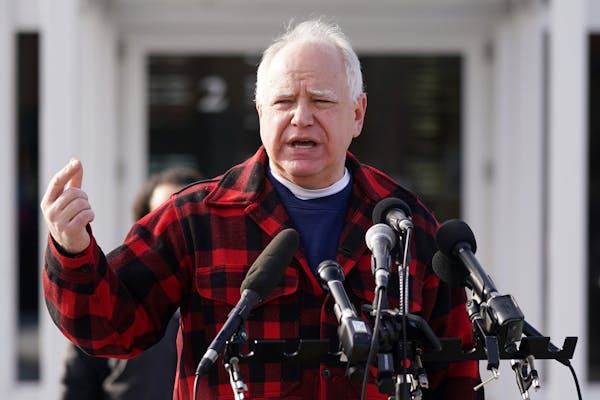Nearly a month into a renewed push to get Minnesota's youngest learners back in school, Gov. Tim Walz on Friday said that the state was positioned to potentially lead the country in the return to in-person learning.
He pointed to what he called a "first-in-the-nation" testing program that has school staff submitting to saliva tests at schools as well as concerted efforts to vaccinate teachers statewide. Positivity rates among those school tests stand at 0.36%, Walz said, helping speed the return of 86% of the state's kindergartners through eighth-graders into at least some form of in-person instruction.
Walz spoke during a visit to Parkview Center School in Rose-ville, where a testing clinic was set up in the cafeteria, and where Principal Kristen Smith-Olson expressed joy over having welcomed back students in kindergarten through fourth grade.
"My goodness, things are going so well," she said.
Walz declined to give a target date for a full return to classroom life, saying such decisions are up to local leaders, but he predicted the state's approach would put it ahead of the school-reopening strategy released Friday by the U.S. Centers for Disease Control and Prevention.
That plan calls for layered mitigation strategies focused on proper mask-wearing and social distancing whenever possible to reduce the spread of COVID-19 — steps common to Minnesota classrooms.
Dr. Rochelle Walensky, the CDC's new director, said students have not been the primary source of COVID-19 for teachers and staff in schools and that "in-person learning in schools has not been associated with substantial community transmission" of the novel coronavirus that causes the infectious disease.
"Most school outbreaks are the result of breaches in mask-wearing and lax mitigation," she said.
The strategy calls for mask-wearing in communities with low viral transmission along with social distancing and the use of pods to group students to limit broad interactions. In communities with higher levels of viral transmission — which Walensky said is the situation in more than 90% of U.S. counties right now — the CDC strategy recommends reduced sports and extracurricular activities.
Routine testing was not mandated as part of the reopening strategy because it isn't broadly available for all districts and hasn't been needed to successfully reopen some schools, Walensky said. "It would be yet another layered protection and that is why we have advocated for it when it's possible. But we don't believe it to be necessary to make it safe."
How Minnesota is doing in reopening schools compared with the rest of the country is unclear. Surveys indicate that 60% of U.S. schools have returned to in-person learning, but that includes partial or hybrid learning models. Donna Harris-Aikens, a senior policy adviser of the U.S. Department of Education, said a more accurate assessment is underway.
"It is critical that we learn how students are learning," she said.
In Roseville, Deborah Legan, a school nurse serving as the district's COVID coordinator, told Walz that testing was key to finding people who have the disease but are not showing symptoms. She said saliva testing began with staff members working with special-education students and had grown to include 265 employees as of Friday. Parkview Center staffers are in their second round of testing, she said.
Legan agreed a multifaceted approach was needed to protect students and staff.
"It isn't one thing that's going to keep our schools safe," she said. "It's not just the mask. It's not just the social distance. It's everything that you have layer after layer after layer."
Fifth- and sixth-graders return to Parkview Center on Feb. 22, followed by seventh- and eighth-graders in a blended learning model on March 15.
Anthony Lonetree • 612-673-4109
Jeremy Olson • 612-673-7744
Body camera video shows Minnetonka man repeatedly shooting at deputies before dying in firefight
Oakdale issues warning after coyote attacks dog in nature preserve

Anoka County extends search for county administrator

Minneapolis schools, teachers reach tentative agreement to avert strike

